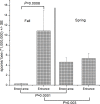Effects of Wintering Environment and Parasite-Pathogen Interactions on Honey Bee Colony Loss in North Temperate Regions
- PMID: 27448049
- PMCID: PMC4957765
- DOI: 10.1371/journal.pone.0159615
Effects of Wintering Environment and Parasite-Pathogen Interactions on Honey Bee Colony Loss in North Temperate Regions
Abstract
Extreme winter losses of honey bee colonies are a major threat to beekeeping but the combinations of factors underlying colony loss remain debatable. We monitored colonies in two environments (colonies wintered indoors or outdoors) and characterized the effects of two parasitic mites, seven viruses, and Nosema on honey bee colony mortality and population loss over winter. Samples were collected from two locations within hives in fall, mid-winter and spring of 2009/2010. Although fall parasite and pathogen loads were similar in outdoor and indoor-wintered colonies, the outdoor-wintered colonies had greater relative reductions in bee population score over winter. Seasonal patterns in deformed wing virus (DWV), black queen cell virus (BQCV), and Nosema level also differed with the wintering environment. DWV and Nosema levels decreased over winter for indoor-wintered colonies but BQCV did not. Both BQCV and Nosema concentration increased over winter in outdoor-wintered colonies. The mean abundance of Varroa decreased and concentration of Sacbrood virus (SBV), Kashmir bee virus (KBV), and Chronic bee paralysis virus (CBPV) increased over winter but seasonal patterns were not affected by wintering method. For most viruses, either entrance or brood area samples were reasonable predictors of colony virus load but there were significant season*sample location interactions for Nosema and BQCV, indicating that care must be taken when selecting samples from a single location. For Nosema spp., the fall entrance samples were better predictors of future infestation levels than were fall brood area samples. For indoor-wintered colonies, Israeli acute paralysis virus IAPV concentration was negatively correlated with spring population size. For outdoor-wintered hives, spring Varroa abundance and DWV concentration were positively correlated with bee loss and negatively correlated with spring population size. Multivariate analyses for fall collected samples indicated higher DWV was associated with colony death as did high SBV for spring-collected samples.
Conflict of interest statement
Figures





Similar articles
-
Risk factors for the presence of Deformed wing virus and Acute bee paralysis virus under temperate and subtropical climate in Argentinian bee colonies.Prev Vet Med. 2017 May 1;140:106-115. doi: 10.1016/j.prevetmed.2017.02.019. Epub 2017 Feb 28. Prev Vet Med. 2017. PMID: 28460743
-
Influence of Honey Bee Genotype and Wintering Method on Wintering Performance of Varroa destructor (Parasitiformes: Varroidae)-Infected Honey Bee (Hymenoptera: Apidae) Colonies in a Northern Climate.J Econ Entomol. 2015 Aug;108(4):1495-505. doi: 10.1093/jee/tov164. Epub 2015 Jun 24. J Econ Entomol. 2015. PMID: 26470288
-
Nationwide Screening for Bee Viruses in Apis mellifera Colonies in Egypt.Insects. 2023 Feb 9;14(2):172. doi: 10.3390/insects14020172. Insects. 2023. PMID: 36835740 Free PMC article.
-
Viral impacts on honey bee populations: A review.Saudi J Biol Sci. 2021 Jan;28(1):523-530. doi: 10.1016/j.sjbs.2020.10.037. Epub 2020 Oct 28. Saudi J Biol Sci. 2021. PMID: 33424335 Free PMC article. Review.
-
Virus Infections of Honeybees Apis Mellifera.Ital J Food Saf. 2015 Sep 25;4(3):5364. doi: 10.4081/ijfs.2015.5364. eCollection 2015 Jun 30. Ital J Food Saf. 2015. PMID: 27800411 Free PMC article. Review.
Cited by
-
Honeybee Colony Growth Period Recognition Based on Multivariate Temperature Feature Extraction and Machine Learning.Sensors (Basel). 2025 Jun 23;25(13):3916. doi: 10.3390/s25133916. Sensors (Basel). 2025. PMID: 40648173 Free PMC article.
-
Effective pest management approaches can mitigate honey bee (Apis mellifera) colony winter loss across a range of weather conditions in small-scale, stationary apiaries.J Insect Sci. 2024 May 1;24(3):15. doi: 10.1093/jisesa/ieae043. J Insect Sci. 2024. PMID: 38805654 Free PMC article.
-
How stressors disrupt honey bee biological traits and overwintering mechanisms.Heliyon. 2024 Jul 10;10(14):e34390. doi: 10.1016/j.heliyon.2024.e34390. eCollection 2024 Jul 30. Heliyon. 2024. PMID: 39108870 Free PMC article. Review.
-
Varroa destructor shapes the unique viral landscapes of the honey bee populations of the Azores archipelago.PLoS Pathog. 2024 Jul 3;20(7):e1012337. doi: 10.1371/journal.ppat.1012337. eCollection 2024 Jul. PLoS Pathog. 2024. PMID: 38959190 Free PMC article.
-
Phenomic analysis of the honey bee pathogen-web and its dynamics on colony productivity, health and social immunity behaviors.PLoS One. 2022 Jan 31;17(1):e0263273. doi: 10.1371/journal.pone.0263273. eCollection 2022. PLoS One. 2022. PMID: 35100308 Free PMC article.
References
-
- Currie RW, Pernal SF, Guzman-Novoa E. Honey bee colony losses in Canada. J Apic Res. 2010;49(1):104–6. .
-
- Guzman-Novoa E, Eccles L, Calvete Y, McGowan J, Kelly PG, Correa-Benitez A. Varroa destructor is the main culprit for the death and reduced populations of overwintered honey bee (Apis mellifera) colonies in Ontario, Canada. Apidologie. 2010;41(4):443–50. 10.1051/apido/2009076 . - DOI
-
- Chauzat P, Laurent M, Rivière M-P, Saugeon C, Hendrikx P, Ribière-Chabert M, et al. A Pan-European Epidemiological Study on Honey Bee Colony Losses 2012–2013. European Union Reference Laboratory for Honeybee Health, Brussels, Rapport technique. 2014.
MeSH terms
LinkOut - more resources
Full Text Sources
Other Literature Sources
Miscellaneous

